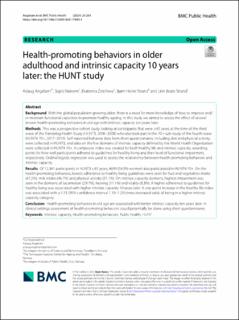| dc.contributor.author | Angelsen, Aslaug | |
| dc.contributor.author | Nakrem, Sigrid | |
| dc.contributor.author | Zotcheva, Ekaterina | |
| dc.contributor.author | Strand, Bjørn Heine | |
| dc.contributor.author | Strand, Linn B | |
| dc.date.accessioned | 2024-03-25T09:43:24Z | |
| dc.date.available | 2024-03-25T09:43:24Z | |
| dc.date.created | 2024-02-02T14:10:01Z | |
| dc.date.issued | 2024 | |
| dc.identifier.citation | BMC Public Health. 2024, 24 (1), 1-10. | en_US |
| dc.identifier.issn | 1471-2458 | |
| dc.identifier.uri | https://hdl.handle.net/11250/3124017 | |
| dc.description.abstract | Background: With the global population growing older, there is a need for more knowledge of how to improve and/or maintain functional capacities to promote healthy ageing. In this study we aimed to assess the effect of several known health-promoting behaviors in old age with intrinsic capacity ten years later.
Methods: This was a prospective cohort study looking at participants that were ≥ 65 years at the time of the third wave of the Trøndelag Health Study (HUNT3, 2006–2008) who also took part in the 70 + sub-study of the fourth wave (HUNT4 70+, 2017–2019). Self-reported behavior data from short questionnaires, including diet and physical activity, were collected in HUNT3, and data on the five domains of intrinsic capacity defined by the World Health Organization were collected in HUNT4 70+. A composite index was created for both healthy life and intrinsic capacity, awarding points for how well participants adhered to guidelines for healthy living and their level of functional impairment, respectively. Ordinal logistic regression was used to assess the relationship between health-promoting behaviors and intrinsic capacity.
Results: Of 12,361 participants in HUNT3 ≥ 65 years, 4699 (56.5% women) also participated in HUNT4 70+. On the health-promoting behaviors, lowest adherence to healthy living guidelines were seen for fruit and vegetables intake (47.2%), milk intake (46.7%) and physical activity (31.1%). On intrinsic capacity domains, highest impairment was seen in the domains of locomotion (29.7%), hearing (11.1%) and vitality (8.3%). A higher adherence to guidelines for healthy living was associated with higher intrinsic capacity 10 years later. A one-point increase in the healthy life index was associated with a 1.15 (95% confidence interval 1.10–1.21) times increased odds of being in a higher intrinsic capacity category.
Conclusion: Health-promoting behaviors in old age are associated with better intrinsic capacity ten years later. In clinical settings assessment of health-promoting behaviors could potentially be done using short questionnaires. | en_US |
| dc.language.iso | eng | en_US |
| dc.publisher | BioMed Central (BMC) | en_US |
| dc.rights | Navngivelse 4.0 Internasjonal | * |
| dc.rights.uri | http://creativecommons.org/licenses/by/4.0/deed.no | * |
| dc.title | Health-promoting behaviors in older adulthood and intrinsic capacity 10 years later: the HUNT study | en_US |
| dc.title.alternative | Health-promoting behaviors in older adulthood and intrinsic capacity 10 years later: the HUNT study | en_US |
| dc.type | Journal article | en_US |
| dc.type | Peer reviewed | en_US |
| dc.description.version | publishedVersion | en_US |
| dc.source.pagenumber | 1-10 | en_US |
| dc.source.volume | 24 | en_US |
| dc.source.journal | BMC Public Health | en_US |
| dc.source.issue | 1 | en_US |
| dc.identifier.doi | 10.1186/s12889-024-17840-3 | |
| dc.identifier.cristin | 2242635 | |
| cristin.ispublished | true | |
| cristin.fulltext | original | |
| cristin.qualitycode | 1 | |

